Figure 5. Morning behavioral anticipation and high amplitude morning startle response behavior persists in flies lacking functional small LNv.
(A) Mean locomotor activity counts of flies living in standard 12 h∶12 h light:dark cycles with pdfGAL4 driven expression of control Q0-Htt (black squares), or Q128-Htt (red dots) and yw controls (grey triangles) are shown. Yellow shaded areas denote mean locomotor activity binned in 15 min intervals during the day while blue shaded areas denote mean locomotor activity at night. Average activity is plotted for age day 1–10 (top panel), age day 11–20 (middle panel) and age day 21–30 (lowest panel) to distinguish age dependent effects. (B) Morning and evening anticipation indices were estimated for individual flies at same 3 life-stages as panel A using the fraction of activity during the 3 hours before the transition states of dawn or dusk compared to the activity level through the six hours before transition (Harrisingh et al 2007). One-way ANOVA on the morning anticipation showed no significant differences between the genetic background controls or yw controls and the experimental lines pdf/Q0-Htt and pdf/Q128-Htt flies through all three life stages. Similar ANOVA was performed on the individual evening anticipation indices at all three lifestages. pdf/Q128-Htt flies exhibited significantly lower evening anticipation compared to pdf/Q0-Htt during the early life stages up to age day 10 (* indicates p<0.01), but during days 21–30 the levels are not different between the two genotypes. But we cannot rule out the non-specific effect of Q128 since yw/q128-Htt flies (genetic background controls) did not show significantly higher anticipation than pdf/Q128-Htt. (C) Group anticipation indices of morning (left panel) and evening activity (right panel), estimate the positive slope of activity for the 4 hours before dawn ZT0 or dusk ZT12 (Stoleru et al 2004; methods of this paper) for both control pdf/Q0-Htt and pdf/Q128-Htt. Relative anticipation indices are plotted for both control pdf/Q0-Htt and pdf/Q128-Htt by normalizing over values of AI for their respective genetic background controls (yw/Q0-Htt and yw/Q128-Htt). Morning anticipation in flies expressing HTT-Q128 in the LNv appears to be not different from controls up to the age of 20 days and during the advanced age group of 21–30 days they show an enhanced level of morning anticipation suggesting that the network of neurons that regulate anticipatory behavior is plastic and undergoes modifications that allow flies to compensate for the lack of functional sLNv. No statistical comparisons were made as single values for anticipation index is obtained by this method from the average activity profile of each genotype. Similarly evening anticipation also appears unaffected by the loss of functional sLNv (right panel).

